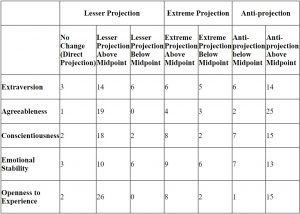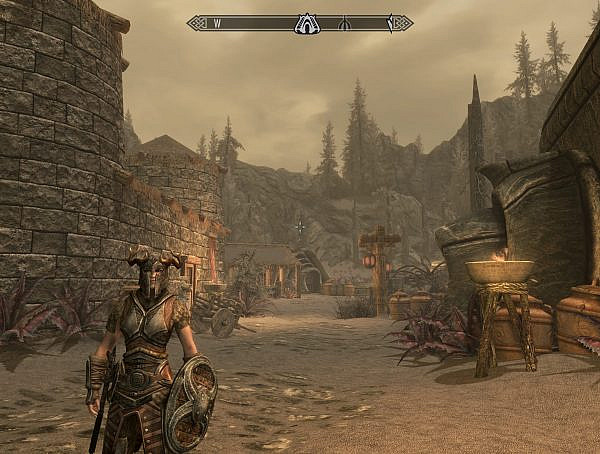Avatars don’t seem to be projection of the identity of the player
In his article “Getting Into the Game: An Examination of Player Personality Projection in Videogame Avatars” Casey Hart examines how people project aspects of their personalities onto their created video game avatars and how people connect with these avatars. Hart approaches the topic using identity theory, examining the relations of the players’ actual self, ideal self and the self projected into a video game avatar created by the players. In Hart’s study, a group of subjects first played a video game, and after playing the participants were evaluated using the Five Factor Personality Inventory (also called the “Big 5 Personality Dimensions”). Hart chose this approach because it has been widely used to examine people from various backgrounds and cultures. The five dimensions of personality examined in the test are extraversion (outgoingness), agreeableness (attributed related to kindness and symphaty), conscientiousness (the personality trait of being careful and/or vigilant), neuroticism (Hart reverses this into emotional stability) , and openness to experience. The subjects were evaluated on how they perceived themselves in relation to these 5 dimensions (actual self), their overall disposition towards the dimensions (ideal self) and how they perceived their avatar in relation to the dimensions (projected self).
Hart’s study included 54 subjects (27 male and 27 female) from a mid-sized Texas university. The group contained 30 people who self-identified as “casual gamers” or “non-gamers” and 24 people who identified as “moderate”, “heavy” or “very heavy gamers” The subjects played Elder Scrolls V: Skyrim (Bethesda Game Studios, 2011). Hart considered some other games for the study (like World of Warcraft and Fallout 4), but ultimately chose Skyrim because of “its highly-detailed and dynamic character creation system, as well as the open-world, non-linear game dynamic”. The study consisted of a pre-experiment survey a week before the actual gameplay session, three hours of gameplay and a post-experiment survey which was completed immediately after playing. In the post-experiment survey, the subjects were asked to answer the questions as their characters would have answered (e.g. “My character is the life of the party”).
The results of Hart’s study seem to suggest that most people have a close connection between their actual self and ideal self. This means that the subjects perceived themselves in a positive way and there was a strong correlation between an individual’s personality and their perceptions about the ideal personality. The results relating to avatar projection, however, seem to show that there is no strong correlation between an individual’s ideal or actual self when compared to their perceptions about their avatars. When examining the correlation of avatars and the ideal selves of subjects, the only personality dimension to show correlation was openness. And even this correlation was weaker than the one between actual self and ideal self positions on openness. Openness was also the only dimension that had a significant correlation when comparing an individual’s actual self and their avatars.
Hart places the relation of player’s actual self and avatar scores (on a scale of 1-5) into a table. In the table, lesser projection means that the avatar score landed between the individual’s subjective score and the midpoint of 3 (for example, when the subjective score was 4.2 and the avatar score was 3.6). Extreme projection occurs when both scores were on the same side of the midpoint but the avatar score was not between 3 and the subjective score (for example, if the individual scored 4 and the avatar score was 4,25). Anti-projection is the case when the subjective score and the avatar score where on different sides of the midpoint. The numbers of the table indicate numbers of participants (each row equals 54).
Hart also pints out the limitations of his study. Quite a few people who started the study did not finish it. While 121 people took the pre-game survey, only 54 finished the whole survey. Hart also says that choosing subjects who self-identify as gamers would be preferable in possible future studies.
Overall, avatars seem to be tools of personality experimentation instead of projection about the player’s personality or ideal personality. While people tend to have a concept of ideal personalities, their avatars don’t seem to manifest these ideals. One exception seems to be openness to new experiences, as it is a trait that seems to be consistently projected in avatars.
Key Information:
Original Article: Getting Into the Game: An Examination of Player Personality Projection in Videogame Avatars
Author: Casey Hart
Published: Game Studies: Volume 17, issue 2, December 2017
Original Article accessible from: http://gamestudies.org/1702/articles/hart
You might also like
More from Game Research Highlights
How do you want to do this? – A look into the therapeutic uses of role-playing games
Can playing RPGs contribute positively to your wellbeing? A recent study aims to find out how RPGs are being used …
Eldritch horrors and tentacles – Defining what “Lovecraftian” is in games
H.P. Lovecrafts legacy lives today in the shared world of Cthulhu Mythos and its iconic monsters. Prema Arasu defines the …
Are Souls Games the Contemporary Myths?
Dom Ford’s Approaching FromSoftware’s Souls Games as Myth reveals the Souls series as a modern mythology where gods fall, desires …

















